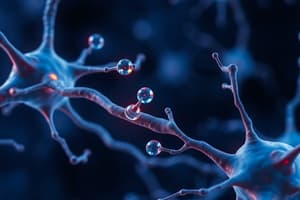Podcast
Questions and Answers
Which of the following are types of synapses? (Select all that apply)
Which of the following are types of synapses? (Select all that apply)
- Axosomatic (correct)
- Axodendritic (correct)
- Axoneural
- Axoaxonic (correct)
What occurs at an axodendritic synapse?
What occurs at an axodendritic synapse?
The axon terminates on the dendrite of another neuron.
What is an axosomatic synapse?
What is an axosomatic synapse?
A synapse between the axon terminal of one neuron and the cell body of a second neuron.
What does it mean if a neuron is presynaptic?
What does it mean if a neuron is presynaptic?
What is the role of synaptic vesicles?
What is the role of synaptic vesicles?
What is the synaptic cleft?
What is the synaptic cleft?
What happens during synaptic transmission's presynaptic events?
What happens during synaptic transmission's presynaptic events?
What initiates postsynaptic events in synaptic transmission?
What initiates postsynaptic events in synaptic transmission?
Which of the following describes an excitatory postsynaptic potential (EPSP)?
Which of the following describes an excitatory postsynaptic potential (EPSP)?
What occurs during inhibitory postsynaptic potential (IPSP)?
What occurs during inhibitory postsynaptic potential (IPSP)?
Match the type of summation with its description:
Match the type of summation with its description:
What are common neurotransmitters?
What are common neurotransmitters?
What are the methods of inactivation of neurotransmitters?
What are the methods of inactivation of neurotransmitters?
Flashcards are hidden until you start studying
Study Notes
Types of Synapses
- Three main types: axodendritic, axosomatic, axoaxonic.
- Axodendritic: axon connects with the dendrite of another neuron.
- Axosomatic: synapse between axon terminal of one neuron and the soma of another neuron.
- Axoaxonic: axon of one neuron synapses with the axon of another neuron.
Presynaptic and Postsynaptic Neurons
- Presynaptic neuron: neuron located before the synapse.
- Postsynaptic neuron: neuron located after the synapse.
Synaptic Vesicles
- Contain neurotransmitters (NT) within the axon terminal of the presynaptic neuron.
- Each neuron secretes only one type of neurotransmitter.
Synaptic Cleft
- The gap that separates presynaptic and postsynaptic neurons.
- Typically 30-50 nanometers wide with a floating membrane.
Postsynaptic Membrane
- Composed of a phospholipid bilayer containing proteins and receptors for neurotransmitters.
Synaptic Transmission - Presynaptic Events
- Action potential (AP) reaches the axon terminal.
- Voltage-gated Ca++ channels open, increasing cytoplasmic Ca++ concentration.
- Ca++ causes synaptic vesicles to move and fuse with the terminal membrane.
- Neurotransmitters are released into the synaptic cleft via exocytosis.
Synaptic Transmission - Postsynaptic Events
- Neurotransmitters bind to receptors on the postsynaptic neuron.
- Chemically gated ion channels open, altering the membrane potential (MP), either depolarizing or hyperpolarizing based on neurotransmitter type.
Postsynaptic Potentials
- Two types of potentials:
- Excitatory Post Synaptic Potential (EPSP): MP moves towards 0mV.
- Inhibitory Post Synaptic Potential (IPSP): MP moves away from 0mV.
Ionic Mechanisms of EPSP
- Monovalent cation channels open upon NT binding, allowing Na+ influx and K+ efflux, driving MP closer to 0mV.
- Calcium channels also open, causing further depolarization.
Ionic Mechanisms of IPSP
- Cl- channels open, allowing negative charge influx, driving MP away from 0mV.
- K+ channels open, causing K+ to exit the cell, enhancing negativity.
Summation in Postsynaptic Neurons
- Postsynaptic neurons require MP to exceed threshold for AP generation.
- Temporal summation: accumulation of events over time.
- Spatial summation: accumulation of events over different locations.
Grand Synaptic Potential
- The combined electrical effect of all EPSPs and IPSPs.
- If the grand potential exceeds threshold, voltage-gated Na+ channels open, initiating an action potential.
Common Neurotransmitters
- Include Acetylcholine (ACh), biogenic amines, amino acids, and peptides.
- Some can have both excitatory and inhibitory effects (e.g., dopamine via D1 and D2 receptors).
Inactivation of Neurotransmitters
- Mechanisms include:
- Reuptake by presynaptic neurons (e.g., serotonin, norepinephrine).
- Uptake by glial cells (e.g., astrocytes handle glutamate).
- Enzymatic degradation in the synaptic cleft (e.g., acetylcholinesterase hydrolyzes ACh).
- Diffusion away from the synapse, potentially entering the bloodstream (e.g., norepinephrine).
Studying That Suits You
Use AI to generate personalized quizzes and flashcards to suit your learning preferences.



